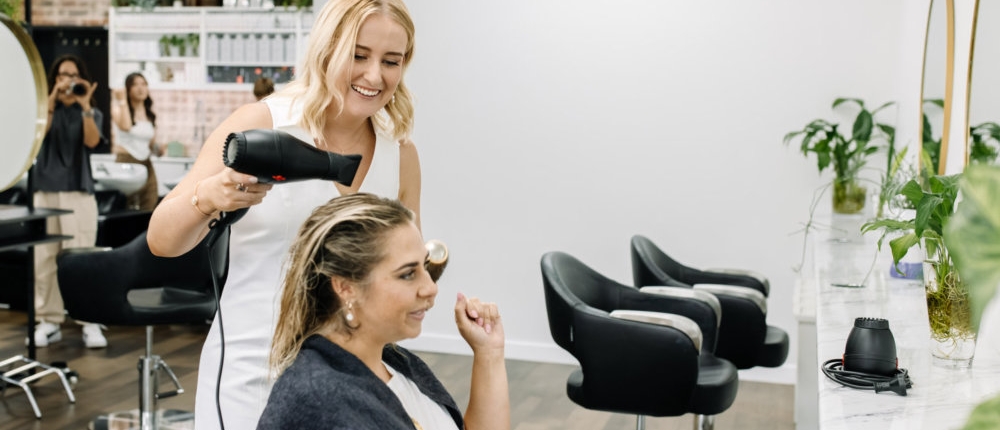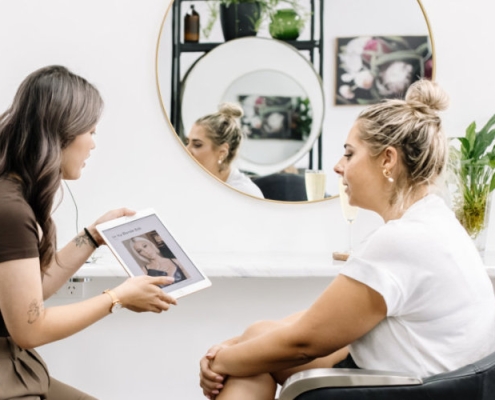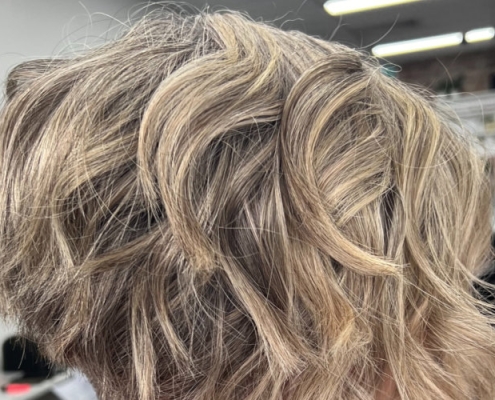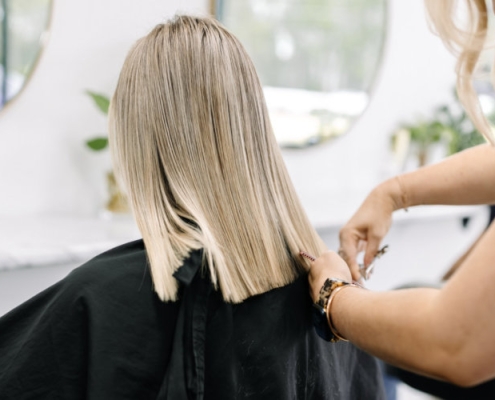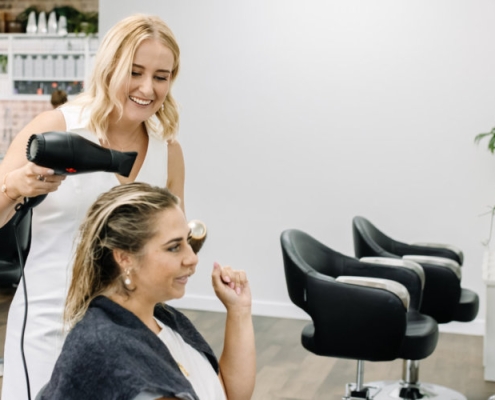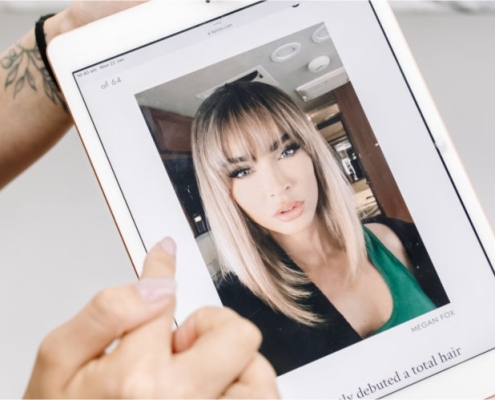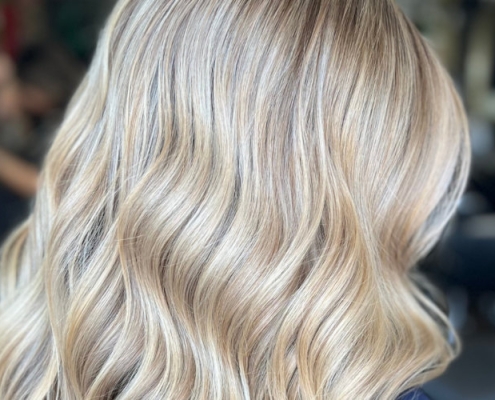How to Go Blonde Without Damaging Your Hair
Dreaming of blonde hair but worried about damage? Lightening hair is a chemical process that, if done incorrectly, can lead to dryness, breakage, and weakened strands. However, with the right techniques, professional guidance, and proper aftercare, you can achieve your desired blonde shade while keeping your hair strong and healthy.
This guide covers everything you need to know about going blonde the right way, including the best methods, essential aftercare, and expert tips to prevent hair damage.
Understanding the Lightening Process
To achieve blonde hair, the hair’s natural pigment must be lifted through a lightening process. The darker your hair, the more lightening sessions may be required to reach your desired blonde shade.
Here’s what happens when hair is lightened:
- Melanin is removed: The natural pigments in your hair are broken down by bleach.
- Porosity increases: Lightened hair becomes more porous, meaning it absorbs and loses moisture faster.
- Protein bonds weaken: If not done carefully, the structure of the hair shaft can become compromised, leading to breakage.
To ensure your blonde transformation is safe and successful, follow these expert-recommended steps.
Step 1: Choose the Right Blonde for Your Hair Type
Not all blonde shades require the same level of lightening. If you’re starting with darker hair, consider opting for a blonde shade that requires less bleaching to minimise damage.
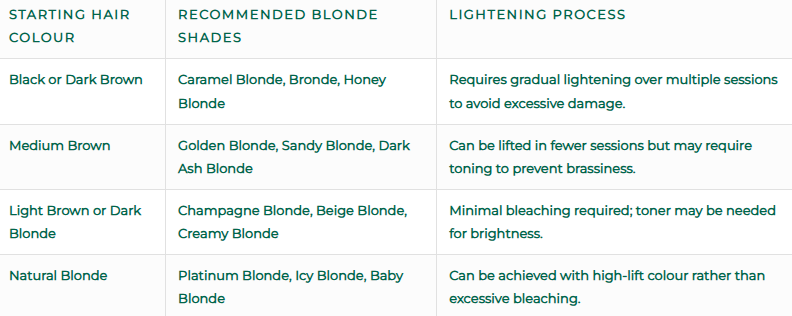
If you’re unsure which shade will suit you best, read The Best Blonde Shades for Different Skin Tones to find your perfect match.
Step 2: Work with a Professional Colourist
Bleaching is a complex process that requires professional expertise. While DIY bleaching kits exist, attempting to lighten hair at home can result in uneven colour, excessive damage, and even hair breakage.
Why You Should Visit a Salon:
- Professionals use high-quality bleach and toners to prevent excessive damage.
- They can assess your hair’s condition and determine the safest way to lighten it.
- They use bond-building treatments to maintain hair strength.
Looking for a professional lightening service? Visit Foils and Lightening Services for expert blonde transformations.
Step 3: Lighten Your Hair Gradually
If you’re transitioning from a dark colour to blonde, it’s best to lighten your hair over multiple sessions rather than in one sitting. This approach:
- Reduces breakage: Giving hair time to recover between sessions prevents excessive dryness.
- Allows for better colour correction: Hair can be toned and adjusted as needed.
- Maintains hair health: Deep conditioning treatments can be used between sessions.
Step 4: Strengthen Your Hair Before and After Bleaching
To prevent hair from becoming brittle after bleaching, start using strengthening treatments before your lightening session.
Pre-Bleach Hair Care:
- Use a deep conditioning treatment once a week for two weeks before bleaching.
- Apply a protein treatment to reinforce the hair shaft.
- Avoid heat styling for at least a week before your appointment.
Post-Bleach Hair Care:
- Use a sulfate-free, colour-safe shampoo to prevent fading.
- Apply a bond-building treatment weekly to maintain hair structure.
- Deep condition regularly to restore moisture and elasticity.
Step 5: Maintain Your Blonde Without Damage
Once you’ve achieved your perfect blonde shade, following a proper maintenance routine is crucial for keeping it vibrant and healthy.
Blonde Hair Maintenance Tips:
- Use a purple shampoo once a week to prevent brassiness.
- Limit heat styling and always use a heat protectant spray.
- Schedule regular toning treatments to maintain your blonde shade.
- Trim hair every 6–8 weeks to prevent split ends.
For more on keeping blonde hair bright, read How to Keep Blonde Hair Bright and Healthy.
Common Mistakes to Avoid When Going Blonde
Going blonde is an exciting transformation, but making mistakes in the process can lead to severe hair damage, breakage, and uneven colour. To ensure your blonde journey is successful, avoid these common pitfalls.
1. Trying to Go Blonde in One Session
One of the biggest mistakes people make is attempting to go from dark brown or black hair to platinum blonde in a single appointment. This over-processes the hair, leading to:
- Extreme dryness and brittleness
- Breakage and split ends
- Scalp irritation and burns
Instead, lighten hair gradually over multiple sessions to maintain its health. Visit How to Go Blonde Without Damaging Your Hair to learn the safest way to lighten hair over time.
2. Skipping Bond-Building Treatments
Bleaching weakens the hair structure by breaking down protein bonds. Without proper reinforcement, hair can become too fragile to handle regular styling.
How to Prevent Damage:
- Use bond-building treatments during and after bleaching.
- Apply a deep conditioning mask weekly to restore hydration.
3. Using the Wrong Toner or Not Toning at All
Many people assume that bleaching alone achieves a perfect blonde shade, but without toning, hair may turn yellow, orange, or even green. Choosing the wrong toner can also lead to an unnatural, dull colour.
How to Tone Correctly:
- Use a purple shampoo once or twice a week to neutralise brassiness.
- For cooler blondes, apply an ash or silver toner to counteract warm tones.
- For warmer blondes, opt for a golden toner to enhance warmth.
4. Washing Blonde Hair Too Often
Washing your hair too frequently strips it of moisture and natural oils, leading to excessive dryness.
How to Wash Blonde Hair Properly:
- Wash hair only two to three times a week to retain moisture.
- Use a sulfate-free, colour-safe shampoo to prevent fading.
5. Attempting DIY Bleaching Without Experience
Bleaching at home without the right knowledge can lead to patchy, over-processed, or even burnt hair. Home bleach kits often lack professional-grade ingredients needed to maintain hair health.
Not sure whether to bleach at home? Read Foils and Lightening Services to explore professional options.
How to Transition to Blonde Gradually
If you want to go blonde but avoid extreme damage, transitioning gradually is the safest and most natural approach. Here are the best techniques for lightening hair without over-processing it.
1. Balayage and Highlights
Balayage and highlights are the best ways to introduce blonde tones without committing to full-on bleaching.
Why Balayage Works for a Gentle Transition:
- Lightens hair without an obvious regrowth line.
- Requires less frequent touch-ups than full-head bleaching.
- Allows your natural colour to blend with the blonde for a low-maintenance effect.
2. Glossing Treatments
Glossing adds subtle blonde tones without using harsh chemicals. It’s an excellent way to enhance natural hair colour while keeping hair healthy.
How It Works:
- Deposits semi-permanent blonde tones onto hair.
- Adds shine and dimension without full bleaching.
- Lasts for 6–8 weeks and fades naturally.
3. Shadow Roots and Lived-In Blonde
If you want a blonde look that grows out seamlessly, shadow roots or lived-in blonde techniques are ideal.
Benefits of Shadow Roots:
- Blends blonde tones with natural root colour.
- Reduces the need for frequent root touch-ups.
- Creates a natural, effortless blonde effect.
DIY vs. Salon Blonde: What You Need to Know
Should you go blonde at home or visit a professional? While it’s possible to lighten your hair at home, there are key differences between DIY and salon results.
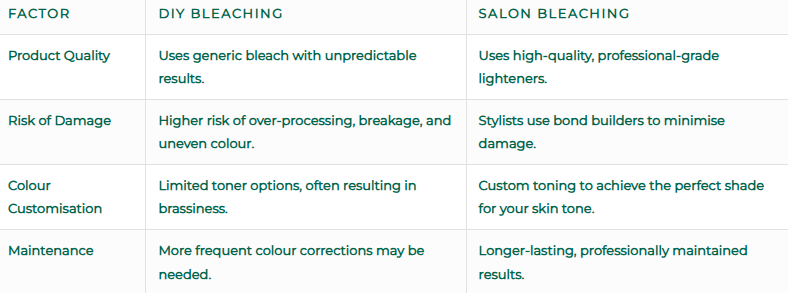
When to Visit a Professional:
- If you’re going from dark brown or black to blonde.
- If you want a platinum, icy, or ultra-light blonde.
- If your hair is prone to dryness or breakage.
For the best blonde results, visit Foils and Lightening Services for a professional, damage-free approach.
Final Thoughts
Going blonde without damage requires the right techniques, gradual lightening, and proper aftercare. Whether you’re transitioning with balayage or committing to a full-head blonde, following expert advice ensures healthy, vibrant results.
Ready to choose your perfect blonde? Read The Best Blonde Shades for Different Skin Tones to find the most flattering shade for you.

